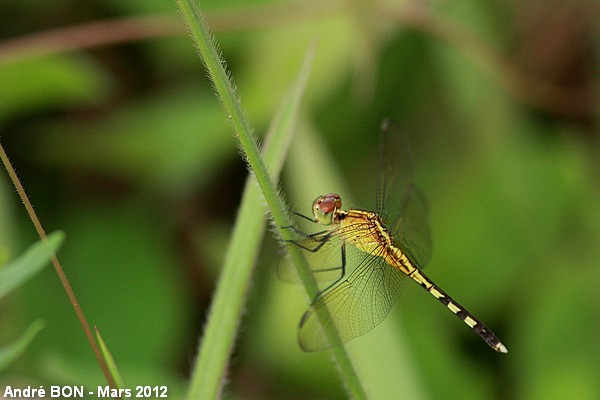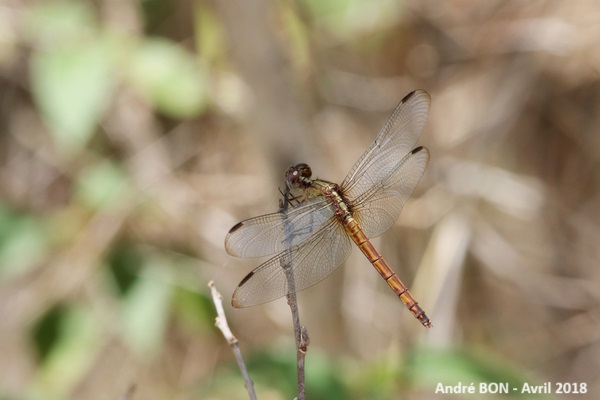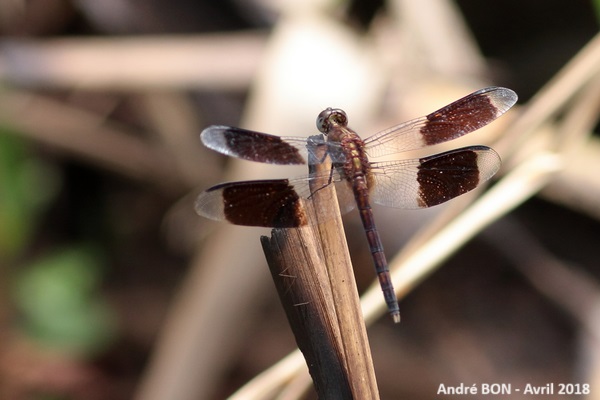



| Band-winged Dragonlet (Erythrodiplax umbrata (Linnaeus, 1758)) |




|
|
Scientific name: Erythrodiplax umbrata (Linnaeus, 1758) Common name: Band-winged Dragonlet French name: Erythrodiplax à quatre bandes Order: Odonata Suborder: Anisoptera Family: Libellulidae Wingspan: 53 to 69 mm. Biotope: Marshes, shallow ponds, temporary waters. Geographic area: South America but missing in Chile and in the southern half of Argentina, Central America (restricted to the eastern part in Mexico), south east of the United States, the Caribbean. Flight time: |
Dragonflies of the Erythrodiplax genus are small size dragonflies which generally hold their wings slightly oriented forward when landed. Erythrodiplax umbrata shows an important sexual dimorphism. Males are a dark colour and bear a wide black band on each wing between the nodus and the pterostigma. Females appear in two forms, one form (andromorph) with the black bands on the wings and one other form (heteromorph) lacking these dark bands. The females' abdomen is generally greenish yellow with one dark dorsal stripe and lateral rectangular dark patches, on the middle segments, which may have a small point forward. Immature males do not have any dark band on the wings and look like heteromorph females. The tip of the wings is slightly darkened. Female Erythrodiplax unimaculata shows lateral patches on the abdomen with a slightly different shape. The pale area appears rather triangular. Experts are used to looking at the layout of the veins on the wings and at females' sub-genital plates to be more confident in telling species apart. |
| [To know more about the Band-winged Dragonlet] [Next picture] [Top] |

|
I have shot this picture at the "Salines" of Rémire-Montjoly. Here is one typical male with its black bands on the wings. |
| [To know more about the Band-winged Dragonlet] [Next picture] [Previous picture] [Top] |

|
I have shot this picture in a waste land in Rémire-Montjoly. The marks on the side of the abdomen are typical. The tight cerci at the tip of the abdomen make me think to an immature male. |
| [To know more about the Band-winged Dragonlet] [Next picture] [Previous picture] [Top] |

|
The identification of this female requires the examination of the layout of veins on the wings. So I worked on it with an excellent document describing a key to the damselflies and dragonflies of Guadeloupe and Martinique by François Meurgey. All criteria were evaluated on the unreduced photo and are perhaps difficult to evaluate on the format displayed here. Pterostigmas have parallel short sides. The last antenodal vein of the forewing is incomplete. There is a single transverse vein in the subnodal sector. The median line of the anal loop is curved at an angle that is less than 50° (the camera angle must be taken into account but it still seems obvious). The cubital vein (CuP) originates at the posterior angle of the discoid cell. The transverse cubito-anal vein is located before the origin of the proximal vein of the anal loop. The Erythrodiplax genus is confirmed. There are two rows of cells between IR3 and Rspl. I am not able to see the size of the vulvar blade. The large size (although not measured) and the presence of a male of Erythrodiplax umbrata nearby made me opt for this last species. |
| [To know more about the Band-winged Dragonlet] [Previous picture] [Top] |

|
Here is the male observed near the above described female. |